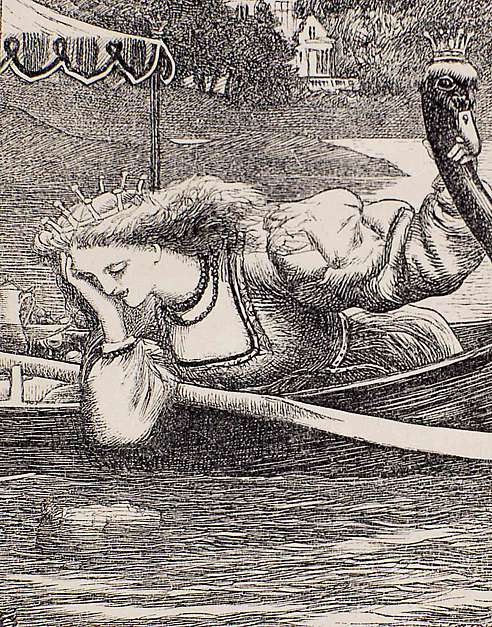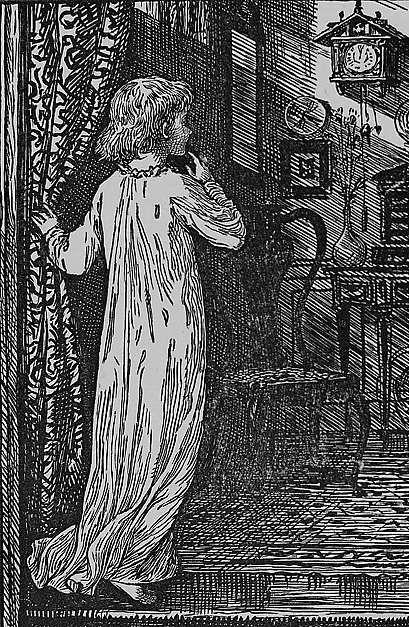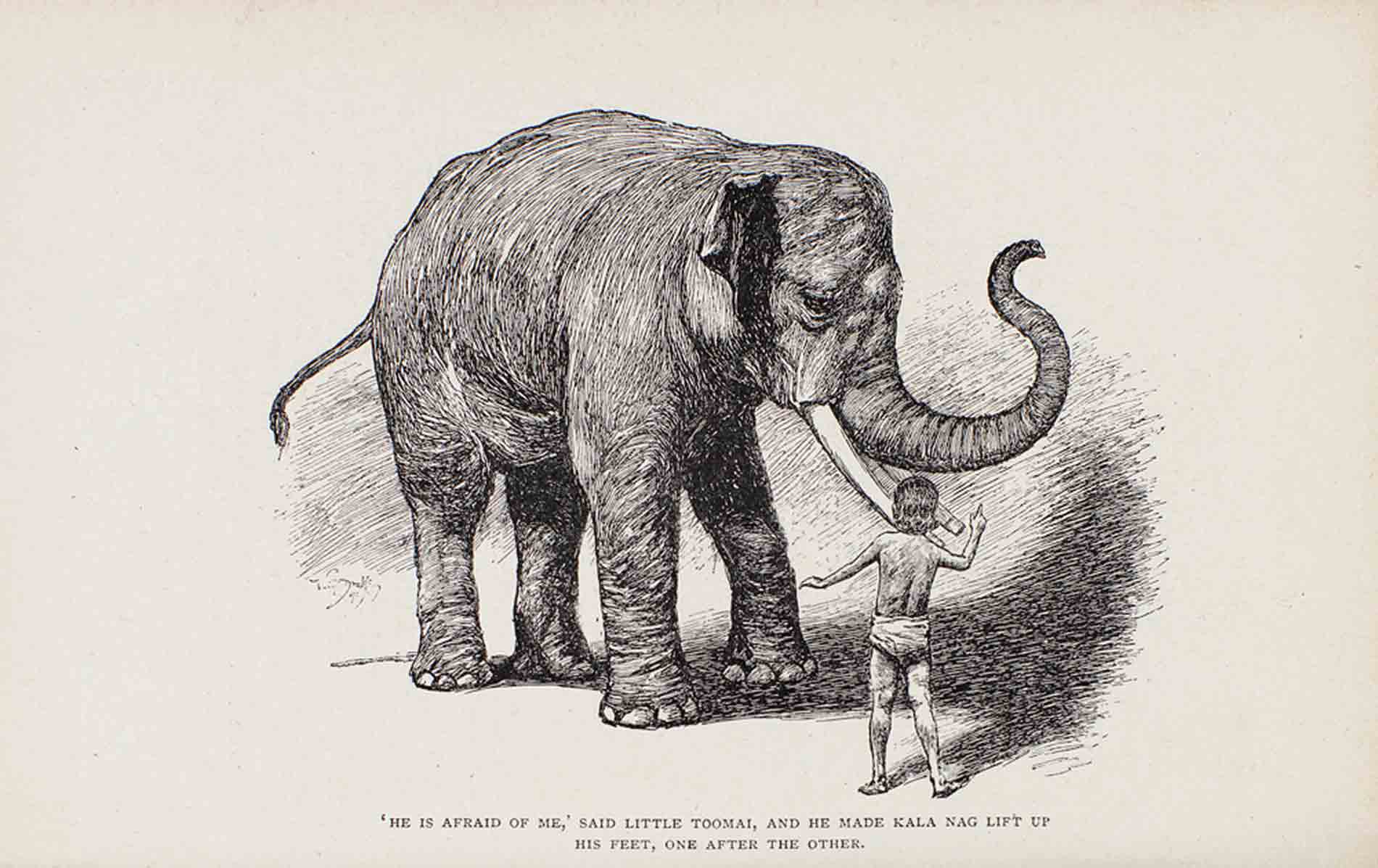The Age of Alice: Fairy Tales, Fantasy, and Nonsense in Victorian England
The Age of Alice: Fairy Tales, Fantasy, and Nonsense in Victorian England
By Ronald Patkus
Alice’s Adventures in Wonderland originated in a tale told by Charles Dodgson (Lewis Carroll) to the children of Henry Liddell, Dean of Christ Church, Oxford, during a boating trip in July of 1862. At the insistence of the children, he began to write out the tale, and his manuscript was completed in 1864. The first copies were printed in July of 1865, though interestingly, few survive which bear this year in the imprint, because most were withdrawn from circulation since the artist, John Tenniel, was dissatisfied with the illustrations. A second run was produced in November of 1865, and dated 1866. Many of the original printed copies were sold to the New York publisher D. Appleton, who added a new title page and binding. Despite this complicated publication history, the book sold well both in England and America, and several other printings followed. The sequel Through the Looking Glass appeared in 1871. After the copyright for Alice’s Adventures expired in 1907, a number of new editions appeared, with illustrations by other artists. What is more, there have been many film, television, and dramatic adaptations of the novel since the early 20th century. Given the wide popularity of Carroll’s work, it’s no surprise that many cultural institutions will be celebrating the publication anniversary in a variety of ways.[1]
As important and influential as Alice’s Adventures in Wonderland was, we should take care not to let it obscure our appreciation of similar works composed by authors besides Carroll during the same period.[2] The Victorian era (1837-1901), after all, witnessed a great outpouring of fairy tales, and works of fantasy and nonsense. In fact, such works begin to appear in the first year of Victoria’s reign, and grew in number in succeeding years, right up to the year of her death. What is more, such books came to the market not only in increasing numbers, but also with increasing success and impact. Over the decades the genre grew, and eventually an audience for these works was created. Whereas at the beginning of the 19th century most books for children had an educational or moralistic bent (one thinks, for instance, of the well-known primers, and poems and hymns by the theologian Isaac Watts), by the end of the century many other kinds of books were being offered as well. There seems to be no exaggeration in calling this “The Age of Alice,” as a way of noting the importance of Carroll’s work while also recognizing the contributions of other literary figures.[3]
One of the earliest novels which showed signs of breaking away from the moralistic tradition in children’s literature was Sara Coleridge’s Phantasmion: A Fairy Tale, which appeared in 1837.[4] Coleridge was the daughter of the Romantic poet Samuel Taylor Coleridge. Apart from some translations, her output was relatively small, and the story of Phantasmion is today regarded as her best-known work. The central figure is Prince Phantasmion of Palmland. The book was well-received at the time, and likely influenced later English writers of fantasy. Yet Coleridge’s Phantasmion was not the only such work to appear in the 1830s. Also of note is Catherine Sinclair’s Holiday House, which was published two years later, in 1839. Sinclair was a Scottish writer who produced many works for children. Holiday House, a story of unruly children, incorporates elements of both nonsense and fantasy, and so departs even further from the didactic tradition. A young John Ruskin in 1841 wrote the fairy tale The King of the Golden River, though it did not appear in prnt until a decade later.
In the 1840s, 50s, and 60s more established authors such as Charles Dickens and William Makepeace Thackeray produced works with fantastical elements. They each did this after having written a number of books of more realistic fiction. In the early 1840s, a number of years after the publication of his first novels like The Pickwick Papers and Oliver Twist, Dickens launched his series of Christmas stories. A Christmas Carol came out in 1843, followed in 1844 by The Chimes: a Goblin Story of Some Bells That Rang an Old Year Out and a New Year In and other stories in succeeding years.[5] In 1855 Thackeray’s satirical fantasy The Rose and the Ring appeared, originally with his own illustrations, and following the publication of his major works. During these decades works also appeared by other authors who were active in fields other than fantasy. For instance, poet Christina Rossetti’s popular The Goblin Market was published in 1862, to be followed later by Speaking Likenesses.
Apart from writers who primarily worked in realistic fiction or other fields, by mid-century several authors had become especially well known as writers of works for children. One of the greatest was George MacDonald, who wrote a number of books, including Phantastes (1858), Dealings with the Fairies (1867, figure 1), At the Back of the North Wind (1871), The Princess and the Goblin (1873), and The Princess and Curdie (1883). MacDonald’s work became quite popular, and in later years influenced other fantasy writers, like C.S. Lewis and J.R.R. Tolkien.[6] Another important writer for children was Mary Molesworth, who wrote under the names “Mrs. Molesworth” and “Ennis Graham.” Her titles include Tell Me a Story (1875), Carrots (1876), The Cuckoo Clock (1877), The Tapestry Room (1879), A Christmas Child (1880), and The Carved Lions (1895). Though he published a range of works, Edward Lear became best-known for his nonsense limericks, as seen especially in his Book of Nonsense, which first appeared in 1846, and went through several editions.

When thinking of the works of fairy tales and fantasy that more and more were being distributed to the market, we should consider not only the literary nature of the works, but also their artifactual qualities. In others words, readers interacted with actual books that had aspects worth considering. One obvious feature is that these books were relatively small, able to be held easily. Another feature is that a number of these books featured illustrations by major artists.[7] Though Carroll’s Alice’s Adventures in Wonderland has over the years been illustrated many times by various artists, one still thinks of the first illustrations created by John Tenniel. Arthur Hughes also illustrated many books of fairy tales and fantasy, including works by George MacDonald and Christina Rossetti. Toward the end of the century, Walter Crane provided illustrations for books by Mary Molesworth (figure 2, from The Cuckoo Clock) and Oscar Wilde. Illustrators played an important role in how a particular book was experienced. In addition to illustrations, books of fairy tales and fantasy also often possessed interesting publisher’s bindings, with gilt lettering or illustrations on the front cover.[8] Typefaces varied, but were common to other books published at the time. It is not unusual to find books with the marks of their young readers (inscriptions, bookmarks, etc) present.

The role of publishers in making books available is crucial. The center of publishing in England at this time, as it had been for centuries, was London, and nearly all of the fairy tales and works of fantasy under discussion here were published there.[9] There were some books issued from other cities, like Cambridge, Oxford, or further north in Edinburgh, but they did not outnumber works published in London. Many of the publishers of fairy tales and works of fantasy are names that are still familiar to us today; they include Chapman and Hall, MacMillan and Co., Smith, Elder & Co., Longmans, Green, and Co., Thomas Nelson and Sons, and Alexander Strahan. Sometimes these publishers issued their books simultaneously from more than one city; works published from London and New York can easily be found.
It’s also important to note that sometimes the literature under discussion did not always appear in books; sometimes it appeared in journals and magazines of the period.[10] The periodical format is significant because it presents literary works in a very different way from the traditional book. Charles Kingsley’s The Water Babies was first published in Macmillan’s Magazine in 1862-63, and F. Anstey’s The Brass Bottle was first seen in The Strand. Both of these periodicals were read by adults, and feature a range of characteristics, such as illustrations, advertisements, and a variety of texts, all of which contribute to a different reading experience. Sometimes the fairy tales and works of fantasy appeared in journals that were specifically intended for children. For example, Norman MacLeod, the editor of Good Words, published his story “The Gold Thread” in Good Words for 1861, and George MacDonald first published At the Back of the North Wind in the same periodical in 1868, before it was made available in book form. Another famous periodical for children was the American publication St. Nicholas; though focusing on American writers, it also published English authors, such as Frances Hodgson Burnett.
The publication of fairy tales and works of fantasy continued in the last years of the 19th century and the early years of the 20th. In fact, it had become clear that a separate strand of literary production had emerged in England alongside realistic fiction. It was at this time that two works of Oscar Wilde were published: The Happy Prince and Other Tales (1888) and A House of Pomegranates (1891). Just a few years later, in 1894 and 1895, The Jungle Book and The Second Jungle Book of Rudyard Kipling appeared (figure 3). Between 1889 and 1910 the Scottish writer Andrew Lang collected literally hundreds of fairy tales and published them in individual volumes, each with its own color, thus for example The Grey Fairy Book (1900) and The Violet Fairy Book (1901). Edith Nesbit wrote more than 60 books for children; during the last year of the Victorian era (1901) her Nine Unlikely Tales appeared. Her three books known as the “Psammead series” began to appear in The Strand in 1902.

One should also pause to note that not all of the works of fantasy that were written and published during the Victorian era were aimed at young audiences. Sometimes writers used this genre to create works aimed at adults. They did this because the genre offered them a way to achieve their literary goals in a way that realistic fiction could not. Perhaps the best example of this trend is William Morris. During his lifetime Morris showed remarkable creativity in a number of areas of artistic endeavor, including painting, textiles, and printing. Yet throughout his life his productivity was especially great in the area of literature, and toward the end of his life a number of works of fantasy appeared. Some of his best-known works in the genre include The Story of the Glittering Plain (1891), Child Christopher and Goldilind the Fair (1895), The Well at the World’s End (1896), The Water of the Wondrous Isles (1897), and The Sundering Flood (1897). These books were made available to the public in trade editions, and several were also published by the Kelmscott Press, Morris’ own private press.[11]
It is apparent that over several decades, the genre of fairy tales and fantasy had developed greatly. And of course the production of works in this vein did not stop when Victoria’s reign came to an end in 1901. To the contrary, the genre expanded further, bringing us in the 20th century works by writers like Beatrix Potter, C.S. Lewis, and J.R.R. Tolkien.Sometimes these more-recent works were based on the inspiration of earlier books. Authors read earlier works and were influenced by them. Just as George MacDonald had read Sara Coleridge, C.S. Lewis in the 20th century would read George Macdonald. The works that have appeared in the 20th century have enjoyed immense popularity, and perhaps this too has obscured some of the attention that should be given to books from the 19th century. Yet the celebration of the 150th anniversary of Alice’s Adventures in Wonderland offers an occasion for us to reconsider not only that work and others by Lewis Carroll—significant as they are—but also others like it written by a range of authors. Even a quick glance makes clear that the field of fairy tales, fantasy, and nonsense in Victorian England was long-lived, rich, and influential.
Notes
- A number of books on Alice’s Adventures in Wonderland have been published. For the publishing history, a recent work worth consulting is Zoe Jaques and Eugene Giddins, Lewis Carroll’s Alice’s Adventures in Wonderland and Through the Looking Glass: A Publishing History (Burlington, VT, 2013). Back
- For a recent studies, see Carole G. Silver, Strange and Secret Peoples: Fairies and Victorian Consciousness ( Oxford, 1999) and Stephen Prickett, Victorian Fantasy (Waco, TX, 2005). Back
- I am grateful to Justin Schiller for suggesting this descriptive phrase. Back
- The claim is made in John Clute and John Grant, The Encyclopedia of Fantasy (London, 1997), p. 185. A discussion of the book is given in Jeffery W. Barbeau’s intellectual biography titled Sara Coleridge: Her Life and Thought (New York, 2014). Back
- See especially Amberyl Malkovich, Charles Dickens and the Victorian Child (New York, 2013). Back
- See Roderick McGillis, For the Childlike: George Macdonald’s Fantasies for Children (Metuchen, NJ, 1992). Back
- Of special note are Brigid Peppin Fantasy: The Golden Age of Fantastic Illustration (New York,1976) and Gordon N. Ray, The Illustrator and the Book in England from 1790 to 1914 (New York, 1976). Back
- Douglas Ball, Victorian Publisher’s Bindings (Willamsburg, VA, 1985). Back
- There are several books on Victorian publishing, including John O. Jordan and Robert L. Patten, eds. Literature in the Marketplace: Victorian Publishing and Reading Practices (Cambridge, 1995). Back
- J. Don Vann and Rosemary T. VanArsdel, eds. Victorian Periodicals and Victorian Society (Toronto, 1994). Back
- The key biography is Fiona MacCarthy, William Morris: A Life for Our Time (London, 1994). Back